Water Cannon Vehicle Market
Water Cannon Vehicle Market Size and Share Forecast Outlook 2025 to 2035
The water cannon vehicle market is projected to grow from USD 1.1 billion in 2025 to USD 1.5 billion by 2035, at a CAGR of 3.9%. Municipal/Industrial Firefighting will dominate with a 44.0% market share, while 6x4/6x6 will lead the chassis/drive segment with a 44.0% share.
Water Cannon Vehicle Market Forecast and Outlook 2025 to 2035
The global water cannon vehicle market is valued at USD 1,050.0 million in 2025. It is slated to reach USD 1,539.4 million by 2035, recording an absolute increase of USD 489.4 million over the forecast period. This translates into a total growth of 46.6%, with the market forecast to expand at a compound annual growth rate (CAGR) of 3.9% between 2025 and 2035. The overall market size is expected to grow by nearly 1.47X during the same period, supported by increasing urbanization and fire safety requirements, growing airport infrastructure development, expanding public safety needs, and rising industrial safety compliance requirements.
The growth of the global water cannon vehicle market is being propelled by several interrelated factors spanning public safety, industrial security, and infrastructure development. Urbanization and the rise of densely populated metropolitan areas are intensifying the need for crowd control and emergency response solutions, positioning water cannon vehicles as essential assets for law enforcement and civil defense agencies. Governments in both developed and emerging economies are prioritizing investments in public safety equipment to address large-scale events, protests, and emergency situations, driving consistent demand for specialized vehicles equipped with high-capacity water delivery systems and advanced maneuverability features.
Airport infrastructure development represents another key driver. As air traffic volumes continue to grow globally, regulatory authorities are emphasizing stringent fire safety measures, particularly for runways, cargo areas, and airport perimeters. Water cannon vehicles, with their rapid-response capabilities and versatile fire suppression systems, are becoming indispensable tools in airport safety management, enabling swift containment of potential fire hazards and ensuring passenger and asset protection.
Industrial safety compliance is also contributing to market expansion. Heavy industries such as oil and gas, chemical processing, and mining are increasingly mandated to adhere to strict fire safety protocols, prompting facility operators to invest in water cannon vehicles as part of comprehensive emergency preparedness strategies. The integration of advanced control systems, remote operation features, and high-pressure pumping mechanisms enhances operational efficiency, safety, and reliability in challenging industrial environments.
Technological innovation is shaping market trends further. Manufacturers are developing water cannon vehicles with improved ergonomics, energy-efficient engines, and multifunctional capabilities, including foam dispersion and chemical neutralization. The integration of telematics, GPS navigation, and automated targeting systems is enhancing precision, operational safety, and situational awareness.
Geographically, regions experiencing rapid urban expansion, heightened industrial activity, and significant investments in public infrastructure—such as North America, Europe, and parts of Asia-Pacific—are anticipated to account for a substantial share of market growth. Meanwhile, emerging markets are witnessing increased adoption due to rising public safety budgets and evolving regulatory standards. Collectively, these factors underscore a robust growth trajectory for the water cannon vehicle market, with manufacturers and end-users poised to benefit from increasing demand driven by safety, regulatory, and infrastructure imperatives across the next decade.
Quick Stats for Water Cannon Vehicle Market
- Water Cannon Vehicle Market Value (2025): USD 1,050.0 million
- Water Cannon Vehicle Market Forecast Value (2035): USD 1,539.4 million
- Water Cannon Vehicle Market Forecast CAGR: 3.9%
- Leading Application Type in Water Cannon Vehicle Market: Municipal/Industrial Firefighting
- Key Growth Regions in Water Cannon Vehicle Market: Asia-Pacific, Europe, and North America
- Key Players in Water Cannon Vehicle Market: Rosenbauer, Oshkosh (Pierce/ARFF), ZIEGLER, Magirus (IVECO), NAFFCO, Morita Holdings
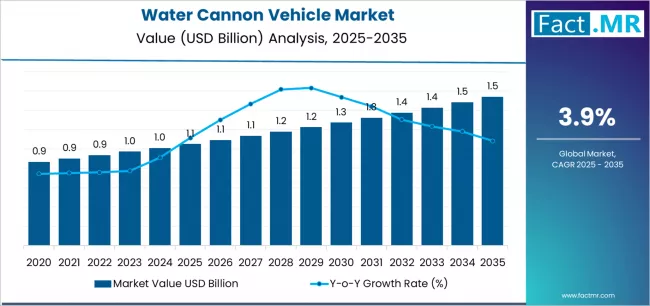
Between 2025 and 2030, the water cannon vehicle market is projected to expand from USD 1,050.0 million to USD 1,271.0 million, resulting in a value increase of USD 221.0 million, which represents 45.2% of the total forecast growth for the decade.
This phase of development will be shaped by increasing urban fire safety regulations, growing airport construction activities, and expanding public safety infrastructure investments. Vehicle manufacturers and emergency services are expanding their water cannon capabilities to address the growing demand for advanced fire suppression and crowd control solutions.
Water Cannon Vehicle Market Key Takeaways
| Metric | Value |
|---|---|
| Estimated Value in (2025E) | USD 1,050.0 million |
| Forecast Value in (2035F) | USD 1,539.4 million |
| Forecast CAGR (2025 to 2035) | 3.9% |
From 2030 to 2035, the market is forecast to grow from USD 1,271.0 million to USD 1,539.4 million, adding another USD 268.4 million, which constitutes 54.8% of the overall ten-year expansion. This period is expected to be characterized by the expansion of smart vehicle technologies, development of autonomous operation capabilities, and growth of integrated emergency response systems. The growing adoption of IoT connectivity and advanced control systems will drive demand for water cannon vehicles with enhanced automation and remote operation capabilities.
Between 2020 and 2025, the water cannon vehicle market experienced steady growth, driven by increasing urban safety requirements and growing recognition of water cannon vehicles as essential equipment for fire suppression, crowd control, and industrial safety applications. The market developed as emergency services and industrial operators recognized the potential for advanced water cannon technology to improve response effectiveness, enhance operational safety, and support comprehensive emergency management while meeting evolving regulatory requirements and operational standards.
Why is the Water Cannon Vehicle Market Growing?
Market expansion is being supported by the increasing urbanization and infrastructure development driven by population growth and economic development, alongside the corresponding need for advanced fire suppression and safety equipment that can protect urban areas, industrial facilities, and critical infrastructure while providing versatile emergency response capabilities across various municipal, industrial, and security applications. Modern emergency services and industrial operators are increasingly focused on implementing advanced water cannon vehicle solutions that can optimize response times, enhance suppression effectiveness, and provide multi-purpose operational capabilities while maintaining safety standards and cost efficiency.
The growing emphasis on public safety and security is driving demand for water cannon vehicles that can support comprehensive emergency response, enable effective crowd control, and ensure multi-functional operational capabilities through advanced water delivery systems and tactical deployment features. Emergency services' preference for vehicles that combine firefighting effectiveness with crowd control capabilities and operational versatility is creating opportunities for innovative water cannon vehicle implementations. The rising influence of industrial safety regulations and airport security requirements is also contributing to increased adoption of water cannon vehicles that can provide specialized suppression capabilities without compromising operational flexibility or response effectiveness.
Segmental Analysis
The market is segmented by application, chassis/drive configuration, water tank capacity, and control system. By application, the market is divided into municipal/industrial firefighting, airport/ARFF, riot control/public order, and industrial/mining special applications. Based on chassis/drive, the market is categorized into 4x2/4x4, 6x4/6x6, and 8x8 & specialty configurations. By water tank capacity, the market is segmented into ≤5,000L, 5,001-10,000L, and >10,000L capacities. By control system, the market is divided into manual/local, electro-hydraulic RC, and fully integrated CAN/PLC systems.
By Application, the Municipal/Industrial Firefighting Segment Leads the Market
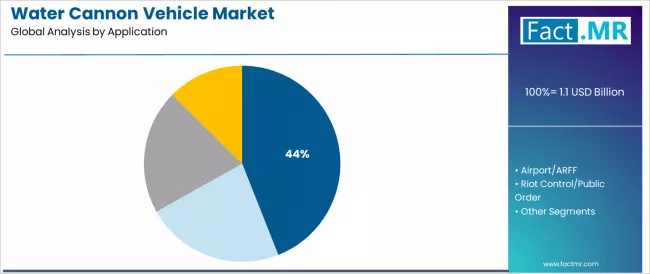
The municipal/industrial firefighting segment is projected to maintain its leading position in the water cannon vehicle market in 2025 with a 44.0% market share, reaffirming its role as the primary application for water cannon vehicle deployment across urban fire departments and industrial safety operations. Fire departments and industrial facilities increasingly utilize water cannon vehicles for their superior water delivery capabilities, extended operational range, and proven effectiveness in handling large-scale fire incidents while maintaining operational safety and response efficiency. Municipal/industrial firefighting application's proven effectiveness and operational versatility directly address emergency service requirements for comprehensive fire suppression and industrial safety protection across diverse urban and industrial environments.
This application segment forms the foundation of modern emergency response, as it represents the application with the greatest contribution to public safety and established operational procedures across multiple fire departments and industrial facilities. Emergency services industry investments in advanced firefighting technologies continue to strengthen adoption among municipal departments and industrial operators. With public safety requirements demanding effective fire suppression and industrial compliance, municipal/industrial firefighting applications align with both safety objectives and regulatory requirements, making them the central component of comprehensive emergency response strategies.
By Chassis/Drive, the 6x4/6x6 Segment Dominates Market Demand
The 6x4/6x6 chassis/drive configuration segment is projected to represent the largest share of water cannon vehicle demand in 2025 with a 44.0% market share, underscoring its critical role as the optimal balance between mobility, payload capacity, and operational versatility for diverse emergency response applications. Operators prefer 6x4/6x6 configurations for water cannon vehicles due to their enhanced stability characteristics, superior load-carrying capacity, and proven effectiveness in varied terrain conditions while supporting comprehensive water tank capacity and equipment integration. Positioned as the ideal configuration for most applications, 6x4/6x6 systems offer both performance capability and operational flexibility advantages.
The segment is supported by continuous innovation in chassis technology and the growing availability of specialized drive systems that enable superior operational performance with enhanced maneuverability and load distribution characteristics. Additionally, vehicle manufacturers are investing in comprehensive chassis optimization programs to support increasingly diverse operational requirements and terrain adaptability demands. As operational complexity increases and mission versatility becomes more important, the 6x4/6x6 configuration will continue to dominate the market while supporting advanced operational strategies and mission capability optimization.
What are the Drivers, Restraints, and Key Trends of the Water Cannon Vehicle Market?
The water cannon vehicle market is advancing steadily due to increasing urbanization and infrastructure development driven by population growth and economic expansion, alongside growing demand for multi-purpose emergency response vehicles that provide firefighting capabilities, crowd control functions, and industrial safety solutions across various municipal, security, and industrial applications. However, the market faces challenges, including high vehicle acquisition and maintenance costs, specialized operator training requirements, and regulatory constraints for crowd control applications in certain regions. Innovation in automation technology and multi-functional design continues to influence vehicle adoption and operational optimization patterns.
Expansion of Airport Infrastructure and ARFF Requirements
The growing airport construction and expansion activities are driving demand for specialized water cannon vehicles that can handle aircraft rescue and firefighting (ARFF) requirements, foam application capabilities, and rapid response deployment through advanced suppression systems and airport-specific operational features. Airport operators require sophisticated ARFF vehicles that deliver specialized suppression capabilities across diverse aircraft types while maintaining response time standards and regulatory compliance. Emergency services are increasingly recognizing the critical importance of advanced ARFF capabilities for aviation safety and regulatory compliance, creating opportunities for specialized vehicles designed for airport applications and aviation emergency response.
Integration of Smart Technologies and Remote Operation
Modern water cannon vehicle manufacturers are incorporating smart technologies and remote operation capabilities to enhance operational safety, enable precise control, and support comprehensive tactical deployment through intelligent control systems and automated operation features.
Leading companies are developing remote-controlled water delivery systems, implementing IoT connectivity, and advancing automation technologies that optimize water cannon deployment while reducing operator risk exposure and improving tactical effectiveness. These technologies improve operational safety while enabling new tactical opportunities, including remote deployment, automated targeting, and comprehensive operational data collection.
Development of Multi-Purpose and Modular Vehicle Designs
The expansion of operational versatility requirements and cost optimization pressures is driving demand for multi-purpose water cannon vehicles with modular design capabilities that can serve firefighting, crowd control, and industrial applications through interchangeable equipment systems and flexible operational configurations. These versatile vehicles require sophisticated engineering capabilities and modular integration systems that exceed traditional single-purpose vehicle requirements, creating premium market segments with enhanced operational flexibility. Manufacturers are investing in modular design research and multi-functional capabilities to serve diverse operational applications while supporting innovation in cost-effective emergency response solutions and operational efficiency optimization.
Analysis of the Water Cannon Vehicle Market by Key Countries
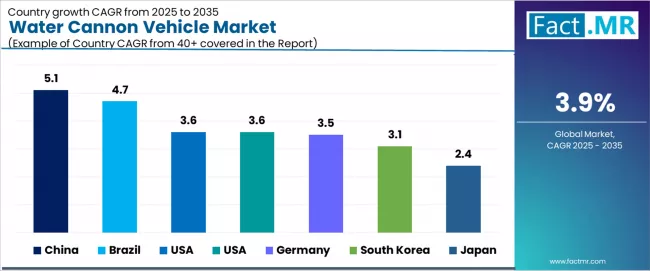
| Country | CAGR (2025-2035) |
|---|---|
| China | 5.1% |
| Brazil | 4.7% |
| USA | 3.6% |
| UK | 3.6% |
| Germany | 3.5% |
| South Korea | 3.1% |
| Japan | 2.4% |
The water cannon vehicle market is experiencing solid growth globally, with China leading at a 5.1% CAGR through 2035, driven by massive urbanization development, expanding public safety infrastructure, and growing industrial safety requirements supporting vehicle demand. Brazil follows at 4.7%, supported by urban development projects, expanding security requirements, and growing public safety investments. Europe shows growth at 3.7%, emphasizing advanced emergency response systems, comprehensive safety standards, and modern vehicle technology integration.
The USA demonstrates 3.6% growth, supported by municipal fleet modernization, airport infrastructure development, and advanced emergency response capabilities. The UK records 3.6%, focusing on public safety enhancement and emergency service modernization. Germany exhibits 3.5% growth, emphasizing engineering excellence and premium emergency vehicle development. South Korea shows 3.1% growth, supported by urban safety infrastructure and advanced vehicle technology. Japan demonstrates 2.4% growth, focusing on disaster preparedness and advanced emergency response systems.
China Leads Global Market Growth with Urbanization and Safety Infrastructure
Revenue from water cannon vehicles in China is projected to exhibit exceptional growth with a CAGR of 5.1% through 2035, driven by massive urbanization development and rapidly expanding public safety infrastructure supporting vehicle adoption among municipal fire departments, public security agencies, and industrial facilities. The country's extensive urban development program and increasing safety infrastructure investments are creating substantial demand for water cannon vehicle solutions. Major emergency vehicle manufacturers and public safety agencies are establishing comprehensive deployment capabilities to serve both urban development and safety infrastructure requirements.
- Strong urbanization development and public safety infrastructure expansion are driving demand for water cannon vehicles throughout major urban regions and industrial clusters across fire departments, security agencies, and industrial safety operations.
- Growing industrial safety requirements and regulatory compliance needs are supporting the rapid adoption of specialized water cannon technologies among industrial operators seeking enhanced safety capabilities and comprehensive emergency response coverage.
Brazil Demonstrates Strong Market Potential with Urban Development and Security
Revenue from water cannon vehicles in Brazil is expanding at a CAGR of 4.7%, supported by the country's urban development projects, expanding security requirements, and increasing public safety investments driving demand for emergency response and crowd control vehicles. The country's growing urban challenges and security considerations are driving demand for versatile water cannon vehicles throughout various public safety applications. Leading emergency service providers and security agencies are establishing comprehensive vehicle capabilities to address growing urban safety and security requirements.
- Strong urban development and expanding security challenges are creating opportunities for water cannon vehicle adoption across municipal fire departments, security forces, and emergency response agencies in major urban centers and metropolitan regions.
- Growing public safety investments and security infrastructure development are driving adoption of multi-purpose water cannon technologies among agencies seeking enhanced operational capabilities and comprehensive emergency response solutions.
USA Focuses on Fleet Modernization and Infrastructure Development
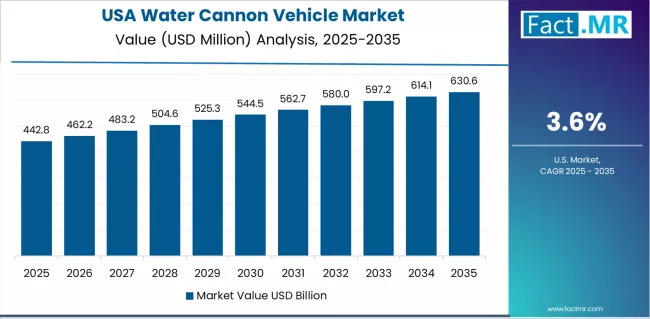
Revenue from water cannon vehicles in the USA is expanding at a CAGR of 3.6%, driven by the country's municipal fleet modernization programs, airport infrastructure development, and advanced emergency response capability enhancement supporting domestic emergency vehicle capacity development. The USA's infrastructure investment and emergency service modernization are supporting investment in advanced water cannon technologies. Major emergency services and airport authorities are establishing comprehensive modernization programs incorporating advanced water cannon vehicles.
- Municipal fleet modernization and airport infrastructure development are creating demand for advanced water cannon vehicles throughout fire departments, airport authorities, and emergency response agencies across major metropolitan areas and aviation hubs.
- Strong emergency service modernization and capability enhancement focus are driving the adoption of advanced water cannon systems among agencies seeking improved response effectiveness and comprehensive operational capabilities for diverse emergency scenarios.
UK Shows Market Leadership with Public Safety Enhancement
Revenue from water cannon vehicles in the UK is expanding at a CAGR of 3.6%, supported by the country's public safety enhancement initiatives, emergency service modernization, and comprehensive safety management supporting water cannon vehicle adoption across diverse emergency response applications. The UK's safety standards and emergency service excellence are driving demand for advanced water cannon solutions. Leading emergency services and security agencies are investing in modernization and capability enhancement programs.
- Public safety enhancement initiatives and emergency service modernization are creating opportunities for water cannon vehicles throughout fire and rescue services, police forces, and airport authorities serving comprehensive safety management requirements.
- Strong safety standards and service excellence focus are driving the adoption of advanced water cannon systems across emergency services seeking enhanced operational effectiveness and comprehensive public safety protection capabilities.
Germany Demonstrates Engineering Excellence with Premium Vehicle Development
Revenue from water cannon vehicles in Germany is expanding at a CAGR of 3.5%, supported by the country's engineering excellence, premium emergency vehicle development capabilities, and advanced safety standards supporting sophisticated water cannon vehicle production and deployment. The nation's technology expertise and quality focus are driving demand for premium water cannon solutions. Leading emergency vehicle manufacturers are investing extensively in advanced technology development and precision manufacturing capabilities.
- Advanced engineering capabilities and premium vehicle development are creating demand for sophisticated water cannon vehicles throughout high-end emergency services and specialized response operations serving premium technology market segments.
- Strong technology innovation and quality standards are supporting the adoption of precision water cannon systems designed for advanced emergency response applications and specialized operational requirements meeting German engineering excellence standards.
South Korea Demonstrates Technology Integration with Urban Safety Focus
Revenue from water cannon vehicles in South Korea is expanding at a CAGR of 3.1%, supported by the country's urban safety infrastructure development, advanced vehicle technology integration, and growing emphasis on comprehensive emergency response capabilities supporting water cannon vehicle adoption. The nation's technology advancement and safety focus are driving demand for intelligent water cannon solutions. Leading emergency services and technology companies are investing extensively in smart emergency response systems and advanced vehicle technologies.
- Urban safety infrastructure development and advanced technology integration are creating demand for smart water cannon vehicles throughout emergency services and security agencies seeking technological advancement and enhanced response capabilities.
- Strong safety focus and technology innovation are supporting the adoption of intelligent water cannon systems designed for urban applications and comprehensive emergency response requirements across modern safety infrastructure.
Japan Shows Premium Focus with Disaster Preparedness Excellence
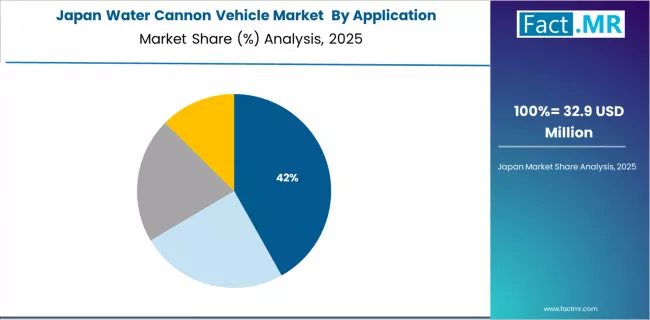
Revenue from water cannon vehicles in Japan is expanding at a CAGR of 2.4%, supported by the country's disaster preparedness excellence, advanced emergency response systems, and strong emphasis on quality and technological innovation supporting premium water cannon vehicle utilization. Japan's technological sophistication and disaster preparedness culture are driving demand for precision emergency response products. Leading emergency service providers are investing in specialized capabilities for advanced disaster response applications and precision technology development.
- Advanced disaster preparedness and emergency response excellence are creating opportunities for premium water cannon vehicles throughout specialized emergency services and disaster response operations serving critical safety applications and quality-focused operational requirements.
- Strong technology innovation and disaster preparedness emphasis are driving adoption of advanced water cannon systems meeting Japanese emergency response standards for excellence and technological sophistication across diverse disaster preparedness applications.
Europe Market Split by Country
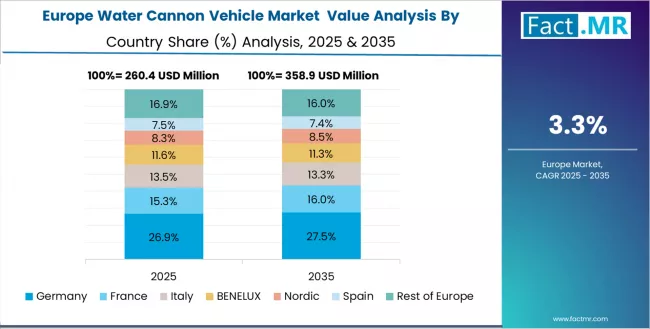
The water cannon vehicle market in Europe is projected to grow from USD 369.9 million in 2025 to USD 530.0 million by 2035, registering a CAGR of 3.7% over the forecast period. Germany is expected to maintain leadership with a 27.6% market share in 2025, moderating to 27.3% by 2035, supported by engineering excellence, premium vehicle development, and advanced safety standards.
France follows with 22.4% in 2025, projected to reach 22.6% by 2035, driven by comprehensive emergency services, public safety focus, and advanced vehicle technology integration. The United Kingdom holds 19.8% in 2025, expected to reach 19.9% by 2035 due to emergency service modernization and safety enhancement initiatives. Italy commands 14.2% in 2025, rising to 14.3% by 2035, while Spain accounts for 10.7% in 2025, reaching 10.8% by 2035. The Rest of Europe region is anticipated to hold 5.3% in 2025 and 5.1% by 2035, reflecting steady emergency vehicle adoption in Nordic countries and emerging safety infrastructure markets in Eastern European countries.
Competitive Landscape of the Water Cannon Vehicle Market
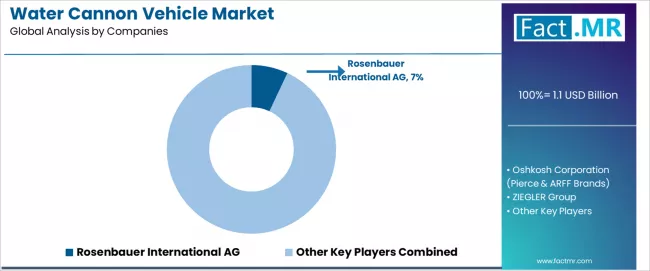
The water cannon vehicle market is characterized by competition among established emergency vehicle manufacturers, specialized firefighting equipment companies, and comprehensive public safety solution providers.
Companies are investing in advanced control system development, multi-purpose vehicle design, automation technology advancement, and comprehensive service capabilities to deliver high-performance, reliable, and versatile water cannon vehicle solutions. Innovation in remote operation capabilities, smart vehicle technologies, and modular design systems is central to strengthening market position and competitive advantage.
Rosenbauer leads the market with a 7.0% share, offering comprehensive water cannon vehicle solutions with focus on advanced firefighting technology, multi-purpose operational capabilities, and extensive global service networks serving diverse emergency response and industrial safety applications.
The company continues investing in automation technologies and smart vehicle systems while expanding production capacity and technical support capabilities. Oshkosh (Pierce/ARFF) provides specialized airport firefighting vehicles with emphasis on ARFF applications and advanced suppression systems. ZIEGLER focuses on municipal firefighting solutions and European market expertise.
Magirus (IVECO) emphasizes integrated emergency response vehicles and comprehensive safety solutions. NAFFCO offers Middle East and emerging market focus with diverse emergency vehicle portfolio. Morita Holdings provides Japanese precision engineering and advanced firefighting technology.
Key Players in the Water Cannon Vehicle Market
- Rosenbauer International AG
- Oshkosh Corporation (Pierce & ARFF Brands)
- ZIEGLER Group
- Magirus GmbH (IVECO Brand)
- NAFFCO (National Fire Fighting Manufacturing FZCO)
- Morita Holdings Corporation
- Angloco Limited
- RMA Fire & Rescue Equipment
- Bronto Skylift (Hi-Reach Division)
- XCMG Fire & Rescue Equipment Co., Ltd.
Scope of the Report
| Items | Values |
|---|---|
| Quantitative Units (2025) | USD 1,050.0 Million |
| Application | Municipal/Industrial Firefighting, Airport/ARFF, Riot Control/Public Order, Industrial/Mining Special |
| Chassis/Drive | 4x2/4x4, 6x4/6x6, 8x8 & Specialty |
| Water Tank Capacity | ≤5,000L, 5,001-10,000L, >10,000L |
| Control System | Manual/Local, Electro-Hydraulic RC, Fully Integrated CAN/PLC |
| Regions Covered | Asia-Pacific, Europe, North America, Latin America, Middle East & Africa |
| Countries Covered | China, Brazil, Germany, USA, UK, Japan, South Korea, and 40+ countries |
| Key Companies Profiled | Rosenbauer, Oshkosh (Pierce/ARFF), ZIEGLER, Magirus (IVECO), NAFFCO, Morita Holdings |
| Additional Attributes | Dollar sales by application and chassis/drive, regional demand trends, competitive landscape, technological advancements in water cannon technology, automation development, smart vehicle innovation, and emergency response optimization |
Water Cannon Vehicle Market by Segments
-
Application :
- Municipal/Industrial Firefighting
- Airport/ARFF
- Riot Control/Public Order
- Industrial/Mining Special
-
Chassis/Drive :
- 4x2/4x4
- 6x4/6x6
- 8x8 & Specialty
-
Water Tank Capacity :
- ≤5,000L
- 5,001-10,000L
- 10,000L
-
Control System :
- Manual/Local
- Electro-Hydraulic RC
- Fully Integrated CAN/PLC
-
Region :
- Asia-Pacific
- China
- Japan
- South Korea
- India
- Australia
- Rest of Asia-Pacific
- Europe
- Germany
- United Kingdom
- France
- Italy
- Spain
- Netherlands
- Rest of Europe
- North America
- United States
- Canada
- Mexico
- Latin America
- Brazil
- Argentina
- Rest of Latin America
- Middle East & Africa
- Kingdom of Saudi Arabia
- South Africa
- Rest of Middle East & Africa
- Asia-Pacific
Table of Content
- Executive Summary
- Global Market Outlook
- Demand to side Trends
- Supply to side Trends
- Technology Roadmap Analysis
- Analysis and Recommendations
- Market Overview
- Market Coverage / Taxonomy
- Market Definition / Scope / Limitations
- Market Background
- Market Dynamics
- Drivers
- Restraints
- Opportunity
- Trends
- Scenario Forecast
- Demand in Optimistic Scenario
- Demand in Likely Scenario
- Demand in Conservative Scenario
- Opportunity Map Analysis
- Product Life Cycle Analysis
- Supply Chain Analysis
- Investment Feasibility Matrix
- Value Chain Analysis
- PESTLE and Porter’s Analysis
- Regulatory Landscape
- Regional Parent Market Outlook
- Production and Consumption Statistics
- Import and Export Statistics
- Market Dynamics
- Global Market Analysis 2020 to 2024 and Forecast, 2025 to 2035
- Historical Market Size Value (USD Million) Analysis, 2020 to 2024
- Current and Future Market Size Value (USD Million) Projections, 2025 to 2035
- Y to o to Y Growth Trend Analysis
- Absolute $ Opportunity Analysis
- Global Market Pricing Analysis 2020 to 2024 and Forecast 2025 to 2035
- Global Market Analysis 2020 to 2024 and Forecast 2025 to 2035, By Application
- Introduction / Key Findings
- Historical Market Size Value (USD Million) Analysis By Application , 2020 to 2024
- Current and Future Market Size Value (USD Million) Analysis and Forecast By Application , 2025 to 2035
- Municipal/Industrial Firefighting
- Airport/ARFF
- Riot Control/Public Order
- Industrial/Mining Special
- Y to o to Y Growth Trend Analysis By Application , 2020 to 2024
- Absolute $ Opportunity Analysis By Application , 2025 to 2035
- Global Market Analysis 2020 to 2024 and Forecast 2025 to 2035, By Chassis/Drive
- Introduction / Key Findings
- Historical Market Size Value (USD Million) Analysis By Chassis/Drive, 2020 to 2024
- Current and Future Market Size Value (USD Million) Analysis and Forecast By Chassis/Drive, 2025 to 2035
- 6x4/6x6
- 4x2/4x4
- 8x8 & Specialty
- Y to o to Y Growth Trend Analysis By Chassis/Drive, 2020 to 2024
- Absolute $ Opportunity Analysis By Chassis/Drive, 2025 to 2035
- Global Market Analysis 2020 to 2024 and Forecast 2025 to 2035, By Region
- Introduction
- Historical Market Size Value (USD Million) Analysis By Region, 2020 to 2024
- Current Market Size Value (USD Million) Analysis and Forecast By Region, 2025 to 2035
- North America
- Latin America
- Western Europe
- Eastern Europe
- East Asia
- South Asia and Pacific
- Middle East & Africa
- Market Attractiveness Analysis By Region
- North America Market Analysis 2020 to 2024 and Forecast 2025 to 2035, By Country
- Historical Market Size Value (USD Million) Trend Analysis By Market Taxonomy, 2020 to 2024
- Market Size Value (USD Million) Forecast By Market Taxonomy, 2025 to 2035
- By Country
- USA
- Canada
- Mexico
- By Application
- By Chassis/Drive
- By Country
- Market Attractiveness Analysis
- By Country
- By Application
- By Chassis/Drive
- Key Takeaways
- Latin America Market Analysis 2020 to 2024 and Forecast 2025 to 2035, By Country
- Historical Market Size Value (USD Million) Trend Analysis By Market Taxonomy, 2020 to 2024
- Market Size Value (USD Million) Forecast By Market Taxonomy, 2025 to 2035
- By Country
- Brazil
- Chile
- Rest of Latin America
- By Application
- By Chassis/Drive
- By Country
- Market Attractiveness Analysis
- By Country
- By Application
- By Chassis/Drive
- Key Takeaways
- Western Europe Market Analysis 2020 to 2024 and Forecast 2025 to 2035, By Country
- Historical Market Size Value (USD Million) Trend Analysis By Market Taxonomy, 2020 to 2024
- Market Size Value (USD Million) Forecast By Market Taxonomy, 2025 to 2035
- By Country
- Germany
- UK
- Italy
- Spain
- France
- Nordic
- BENELUX
- Rest of Western Europe
- By Application
- By Chassis/Drive
- By Country
- Market Attractiveness Analysis
- By Country
- By Application
- By Chassis/Drive
- Key Takeaways
- Eastern Europe Market Analysis 2020 to 2024 and Forecast 2025 to 2035, By Country
- Historical Market Size Value (USD Million) Trend Analysis By Market Taxonomy, 2020 to 2024
- Market Size Value (USD Million) Forecast By Market Taxonomy, 2025 to 2035
- By Country
- Russia
- Poland
- Hungary
- Balkan & Baltic
- Rest of Eastern Europe
- By Application
- By Chassis/Drive
- By Country
- Market Attractiveness Analysis
- By Country
- By Application
- By Chassis/Drive
- Key Takeaways
- East Asia Market Analysis 2020 to 2024 and Forecast 2025 to 2035, By Country
- Historical Market Size Value (USD Million) Trend Analysis By Market Taxonomy, 2020 to 2024
- Market Size Value (USD Million) Forecast By Market Taxonomy, 2025 to 2035
- By Country
- China
- Japan
- South Korea
- By Application
- By Chassis/Drive
- By Country
- Market Attractiveness Analysis
- By Country
- By Application
- By Chassis/Drive
- Key Takeaways
- South Asia and Pacific Market Analysis 2020 to 2024 and Forecast 2025 to 2035, By Country
- Historical Market Size Value (USD Million) Trend Analysis By Market Taxonomy, 2020 to 2024
- Market Size Value (USD Million) Forecast By Market Taxonomy, 2025 to 2035
- By Country
- India
- ASEAN
- Australia & New Zealand
- Rest of South Asia and Pacific
- By Application
- By Chassis/Drive
- By Country
- Market Attractiveness Analysis
- By Country
- By Application
- By Chassis/Drive
- Key Takeaways
- Middle East & Africa Market Analysis 2020 to 2024 and Forecast 2025 to 2035, By Country
- Historical Market Size Value (USD Million) Trend Analysis By Market Taxonomy, 2020 to 2024
- Market Size Value (USD Million) Forecast By Market Taxonomy, 2025 to 2035
- By Country
- Kingdom of Saudi Arabia
- Other GCC Countries
- Turkiye
- South Africa
- Other African Union
- Rest of Middle East & Africa
- By Application
- By Chassis/Drive
- By Country
- Market Attractiveness Analysis
- By Country
- By Application
- By Chassis/Drive
- Key Takeaways
- Key Countries Market Analysis
- USA
- Pricing Analysis
- Market Share Analysis, 2024
- By Application
- By Chassis/Drive
- Canada
- Pricing Analysis
- Market Share Analysis, 2024
- By Application
- By Chassis/Drive
- Mexico
- Pricing Analysis
- Market Share Analysis, 2024
- By Application
- By Chassis/Drive
- Brazil
- Pricing Analysis
- Market Share Analysis, 2024
- By Application
- By Chassis/Drive
- Chile
- Pricing Analysis
- Market Share Analysis, 2024
- By Application
- By Chassis/Drive
- Germany
- Pricing Analysis
- Market Share Analysis, 2024
- By Application
- By Chassis/Drive
- UK
- Pricing Analysis
- Market Share Analysis, 2024
- By Application
- By Chassis/Drive
- Italy
- Pricing Analysis
- Market Share Analysis, 2024
- By Application
- By Chassis/Drive
- Spain
- Pricing Analysis
- Market Share Analysis, 2024
- By Application
- By Chassis/Drive
- France
- Pricing Analysis
- Market Share Analysis, 2024
- By Application
- By Chassis/Drive
- India
- Pricing Analysis
- Market Share Analysis, 2024
- By Application
- By Chassis/Drive
- ASEAN
- Pricing Analysis
- Market Share Analysis, 2024
- By Application
- By Chassis/Drive
- Australia & New Zealand
- Pricing Analysis
- Market Share Analysis, 2024
- By Application
- By Chassis/Drive
- China
- Pricing Analysis
- Market Share Analysis, 2024
- By Application
- By Chassis/Drive
- Japan
- Pricing Analysis
- Market Share Analysis, 2024
- By Application
- By Chassis/Drive
- South Korea
- Pricing Analysis
- Market Share Analysis, 2024
- By Application
- By Chassis/Drive
- Russia
- Pricing Analysis
- Market Share Analysis, 2024
- By Application
- By Chassis/Drive
- Poland
- Pricing Analysis
- Market Share Analysis, 2024
- By Application
- By Chassis/Drive
- Hungary
- Pricing Analysis
- Market Share Analysis, 2024
- By Application
- By Chassis/Drive
- Kingdom of Saudi Arabia
- Pricing Analysis
- Market Share Analysis, 2024
- By Application
- By Chassis/Drive
- Turkiye
- Pricing Analysis
- Market Share Analysis, 2024
- By Application
- By Chassis/Drive
- South Africa
- Pricing Analysis
- Market Share Analysis, 2024
- By Application
- By Chassis/Drive
- USA
- Market Structure Analysis
- Competition Dashboard
- Competition Benchmarking
- Market Share Analysis of Top Players
- By Regional
- By Application
- By Chassis/Drive
- Competition Analysis
- Competition Deep Dive
- Rosenbauer International AG
- Overview
- Product Portfolio
- Profitability by Market Segments (Product/Age /Sales Channel/Region)
- Sales Footprint
- Strategy Overview
- Marketing Strategy
- Product Strategy
- Channel Strategy
- Oshkosh Corporation (Pierce & ARFF Brands)
- ZIEGLER Group
- Magirus GmbH (IVECO Brand)
- NAFFCO (National Fire Fighting Manufacturing FZCO)
- Morita Holdings Corporation
- Angloco Limited
- RMA Fire & Rescue Equipment
- Bronto Skylift (Hi-Reach Division)
- XCMG Fire & Rescue Equipment Co., Ltd.
- Rosenbauer International AG
- Competition Deep Dive
- Assumptions & Acronyms Used
- Research Methodology
List Of Table
- Table 1: Global Market Value (USD Million) Forecast by Region, 2020 to 2035
- Table 2: Global Market Value (USD Million) Forecast by Application , 2020 to 2035
- Table 3: Global Market Value (USD Million) Forecast by Chassis/Drive, 2020 to 2035
- Table 4: North America Market Value (USD Million) Forecast by Country, 2020 to 2035
- Table 5: North America Market Value (USD Million) Forecast by Application , 2020 to 2035
- Table 6: North America Market Value (USD Million) Forecast by Chassis/Drive, 2020 to 2035
- Table 7: Latin America Market Value (USD Million) Forecast by Country, 2020 to 2035
- Table 8: Latin America Market Value (USD Million) Forecast by Application , 2020 to 2035
- Table 9: Latin America Market Value (USD Million) Forecast by Chassis/Drive, 2020 to 2035
- Table 10: Western Europe Market Value (USD Million) Forecast by Country, 2020 to 2035
- Table 11: Western Europe Market Value (USD Million) Forecast by Application , 2020 to 2035
- Table 12: Western Europe Market Value (USD Million) Forecast by Chassis/Drive, 2020 to 2035
- Table 13: Eastern Europe Market Value (USD Million) Forecast by Country, 2020 to 2035
- Table 14: Eastern Europe Market Value (USD Million) Forecast by Application , 2020 to 2035
- Table 15: Eastern Europe Market Value (USD Million) Forecast by Chassis/Drive, 2020 to 2035
- Table 16: East Asia Market Value (USD Million) Forecast by Country, 2020 to 2035
- Table 17: East Asia Market Value (USD Million) Forecast by Application , 2020 to 2035
- Table 18: East Asia Market Value (USD Million) Forecast by Chassis/Drive, 2020 to 2035
- Table 19: South Asia and Pacific Market Value (USD Million) Forecast by Country, 2020 to 2035
- Table 20: South Asia and Pacific Market Value (USD Million) Forecast by Application , 2020 to 2035
- Table 21: South Asia and Pacific Market Value (USD Million) Forecast by Chassis/Drive, 2020 to 2035
- Table 22: Middle East & Africa Market Value (USD Million) Forecast by Country, 2020 to 2035
- Table 23: Middle East & Africa Market Value (USD Million) Forecast by Application , 2020 to 2035
- Table 24: Middle East & Africa Market Value (USD Million) Forecast by Chassis/Drive, 2020 to 2035
List Of Figures
- Figure 1: Global Market Pricing Analysis
- Figure 2: Global Market Value (USD Million) Forecast 2020-2035
- Figure 3: Global Market Value Share and BPS Analysis by Application , 2025 and 2035
- Figure 4: Global Market Y to o to Y Growth Comparison by Application , 2025-2035
- Figure 5: Global Market Attractiveness Analysis by Application
- Figure 6: Global Market Value Share and BPS Analysis by Chassis/Drive, 2025 and 2035
- Figure 7: Global Market Y to o to Y Growth Comparison by Chassis/Drive, 2025-2035
- Figure 8: Global Market Attractiveness Analysis by Chassis/Drive
- Figure 9: Global Market Value (USD Million) Share and BPS Analysis by Region, 2025 and 2035
- Figure 10: Global Market Y to o to Y Growth Comparison by Region, 2025-2035
- Figure 11: Global Market Attractiveness Analysis by Region
- Figure 12: North America Market Incremental Dollar Opportunity, 2025-2035
- Figure 13: Latin America Market Incremental Dollar Opportunity, 2025-2035
- Figure 14: Western Europe Market Incremental Dollar Opportunity, 2025-2035
- Figure 15: Eastern Europe Market Incremental Dollar Opportunity, 2025-2035
- Figure 16: East Asia Market Incremental Dollar Opportunity, 2025-2035
- Figure 17: South Asia and Pacific Market Incremental Dollar Opportunity, 2025-2035
- Figure 18: Middle East & Africa Market Incremental Dollar Opportunity, 2025-2035
- Figure 19: North America Market Value Share and BPS Analysis by Country, 2025 and 2035
- Figure 20: North America Market Value Share and BPS Analysis by Application , 2025 and 2035
- Figure 21: North America Market Y to o to Y Growth Comparison by Application , 2025-2035
- Figure 22: North America Market Attractiveness Analysis by Application
- Figure 23: North America Market Value Share and BPS Analysis by Chassis/Drive, 2025 and 2035
- Figure 24: North America Market Y to o to Y Growth Comparison by Chassis/Drive, 2025-2035
- Figure 25: North America Market Attractiveness Analysis by Chassis/Drive
- Figure 26: Latin America Market Value Share and BPS Analysis by Country, 2025 and 2035
- Figure 27: Latin America Market Value Share and BPS Analysis by Application , 2025 and 2035
- Figure 28: Latin America Market Y to o to Y Growth Comparison by Application , 2025-2035
- Figure 29: Latin America Market Attractiveness Analysis by Application
- Figure 30: Latin America Market Value Share and BPS Analysis by Chassis/Drive, 2025 and 2035
- Figure 31: Latin America Market Y to o to Y Growth Comparison by Chassis/Drive, 2025-2035
- Figure 32: Latin America Market Attractiveness Analysis by Chassis/Drive
- Figure 33: Western Europe Market Value Share and BPS Analysis by Country, 2025 and 2035
- Figure 34: Western Europe Market Value Share and BPS Analysis by Application , 2025 and 2035
- Figure 35: Western Europe Market Y to o to Y Growth Comparison by Application , 2025-2035
- Figure 36: Western Europe Market Attractiveness Analysis by Application
- Figure 37: Western Europe Market Value Share and BPS Analysis by Chassis/Drive, 2025 and 2035
- Figure 38: Western Europe Market Y to o to Y Growth Comparison by Chassis/Drive, 2025-2035
- Figure 39: Western Europe Market Attractiveness Analysis by Chassis/Drive
- Figure 40: Eastern Europe Market Value Share and BPS Analysis by Country, 2025 and 2035
- Figure 41: Eastern Europe Market Value Share and BPS Analysis by Application , 2025 and 2035
- Figure 42: Eastern Europe Market Y to o to Y Growth Comparison by Application , 2025-2035
- Figure 43: Eastern Europe Market Attractiveness Analysis by Application
- Figure 44: Eastern Europe Market Value Share and BPS Analysis by Chassis/Drive, 2025 and 2035
- Figure 45: Eastern Europe Market Y to o to Y Growth Comparison by Chassis/Drive, 2025-2035
- Figure 46: Eastern Europe Market Attractiveness Analysis by Chassis/Drive
- Figure 47: East Asia Market Value Share and BPS Analysis by Country, 2025 and 2035
- Figure 48: East Asia Market Value Share and BPS Analysis by Application , 2025 and 2035
- Figure 49: East Asia Market Y to o to Y Growth Comparison by Application , 2025-2035
- Figure 50: East Asia Market Attractiveness Analysis by Application
- Figure 51: East Asia Market Value Share and BPS Analysis by Chassis/Drive, 2025 and 2035
- Figure 52: East Asia Market Y to o to Y Growth Comparison by Chassis/Drive, 2025-2035
- Figure 53: East Asia Market Attractiveness Analysis by Chassis/Drive
- Figure 54: South Asia and Pacific Market Value Share and BPS Analysis by Country, 2025 and 2035
- Figure 55: South Asia and Pacific Market Value Share and BPS Analysis by Application , 2025 and 2035
- Figure 56: South Asia and Pacific Market Y to o to Y Growth Comparison by Application , 2025-2035
- Figure 57: South Asia and Pacific Market Attractiveness Analysis by Application
- Figure 58: South Asia and Pacific Market Value Share and BPS Analysis by Chassis/Drive, 2025 and 2035
- Figure 59: South Asia and Pacific Market Y to o to Y Growth Comparison by Chassis/Drive, 2025-2035
- Figure 60: South Asia and Pacific Market Attractiveness Analysis by Chassis/Drive
- Figure 61: Middle East & Africa Market Value Share and BPS Analysis by Country, 2025 and 2035
- Figure 62: Middle East & Africa Market Value Share and BPS Analysis by Application , 2025 and 2035
- Figure 63: Middle East & Africa Market Y to o to Y Growth Comparison by Application , 2025-2035
- Figure 64: Middle East & Africa Market Attractiveness Analysis by Application
- Figure 65: Middle East & Africa Market Value Share and BPS Analysis by Chassis/Drive, 2025 and 2035
- Figure 66: Middle East & Africa Market Y to o to Y Growth Comparison by Chassis/Drive, 2025-2035
- Figure 67: Middle East & Africa Market Attractiveness Analysis by Chassis/Drive
- Figure 68: Global Market - Tier Structure Analysis
- Figure 69: Global Market - Company Share Analysis
- FAQs -
How big is the water cannon vehicle market in 2025?
The global water cannon vehicle market is estimated to be valued at USD 1.1 billion in 2025.
What will be the size of water cannon vehicle market in 2035?
The market size for the water cannon vehicle market is projected to reach USD 1.5 billion by 2035.
How much will be the water cannon vehicle market growth between 2025 and 2035?
The water cannon vehicle market is expected to grow at a 3.9?GR between 2025 and 2035.
What are the key product types in the water cannon vehicle market ?
The key product types in water cannon vehicle market are municipal/industrial firefighting, airport/arff, riot control/public order and industrial/mining special.
Which chassis/drive segment to contribute significant share in the water cannon vehicle market in 2025?
In terms of chassis/drive, 6x4/6x6 segment to command 44.0% share in the water cannon vehicle market in 2025.